This post is to document the power and importance of the “Log End Line” when using the Email2Log. You don’t *have to* use the Log End Line, but a few scenarios came up recently where I really understood how (1) powerful it is and how (2) important it is.
This blog post is kind of long, but it’s a lot of pictures, and it’s meant to be comprehensive coverage of the Log End Line.
Note that the Log End Line is optional (you don’t have to use it), but I hope that after you go through this post you’ll know why you should use it (at least sometimes).
What is the Log End Line and Where do I set it up?
The Log End Line is one of the three fields you fill out in order to activate the Email2Log feature (remember, this is a premium feature). Mouse over Logs, then click on Email2Log:
Then, you’ll see the form, where the third field is for the Log End Line:
You can put anything you want as the Log End Line. I do not recommend putting anything that any normal human being might put in an email, like —————–, ____________________, ==================, *****************, or other such characters. Those might be normal separators that anyone could type in, and it would effectively mess up what you are trying to do with the Email2Log.
Our example (see the red dotted line in the image above) is a series of characters that most people aren’t ever going to type… it’s kind of hard to type that string. That’s what I’ve been using for years. You can simply copy and paste that into the Log End Line textbox, if you want.
How and when do I use the Log End Line?
I include my Log End Line in every email that I send. My email signature looks like this:
Every email client I know of allows you to create an email signature. This way you don’t have to retype it every time you send an email. (As a side-note, I’m really big on signatures and think they are powerful personal branding tools!)
I never delete this, as it simply looks like a natural line separator between the body (which goes above) and the rest of the email signature. So it doesn’t detract or distract.
The main idea behind, and most common use of, the Log End Line is that anything after the Log End Line IS NOT included in a Log Entry created when you use Email2Log. To say it in a more technical way, the Log Entry created will be truncated after the Log End Line. More on that in the next section.
Tip: some advanced users will put the Log End Line under their email signature, and then change the font to white, so it isn’t seen by email recipients. I don’t do that, but I think it’s kind of clever 🙂
What does the Log End Line do? (Part 1: Power)
The power of the Log End Line is that it truncates your email so you aren’t creating long Log Entries with a bunch of unwanted text. Use the Log End Line to smartly cut the Log Entry so that you only have what you want, and not all the superfluous stuff. For example, in this image you can see I have NOT edited my Log End Line, which means that ONLY my reply will be in the Log Entry created by Email2Log.
However, the original message is really something I want to include in my Log Entry (it gives my reply context, and it includes a phone number and location for this contact – that’s good stuff). Therefore, with this email I would actually delete two characters (I do two simply because it keeps the Log End Line symmetric… I could delete just one and it would have the same effect). Here’s what the new one looks like, less two characters.. note that this ENTIRE email is going to go into the Log Entry:
Is it hard to see the difference between the two? That subtlety is exactly what I want … I don’t want you to think “oh, something is different… WHY?”
Tip: If I want to include some stuff below my email signature, but not EVERYTHING below my email signature, I will copy the entire Log End Line and paste it where I want to truncate (for example, after your name or your email signature, in the case that there is stuff your email signature (like a disclosure, or more of the email thread), and then I will go to my original Log End Line, above my signature, and then delete two characters.
This ability to truncate your Log Entry, simply by putting a string of characters (aka, the Log End Line) in your email, is POWERFUL!
What does the Log End Line do? (Part 2: Importance)
Did you know you could put some special lines into your email and multiple the power of your Email2Log Log Entry? For example, with a few lines in the email I could make the Log Entry an Action Item, and I could associate it to other Contacts, Companies and Jobs. This is really cool. My email might include these special lines:
Some important information about each of these lines (which are all optional):
startdate:
This creates an Action Item. You can put in a date, like 12/12/2014 or you can put in something like + 1 week or + 3 months, etc. Sometimes you’ll know the date for the Action Items, sometimes the date doesn’t matter (“ah, remind me in a few months”).
contacts: (or, contact:)
You need to have at least one email address. You can have more, separated by commas. If you put in either of the examples below, it will (a) associate this Log Entry to an existing Contact with the same email address, or if it can’t find that email address on any of your Contacts, it will create a new Contact record. The key is that it is looking for and matching based on an email address, not on a name. Examples of what this line might look like:
contacts:email@address.com <– no FirstName or LastName required – I’m assuming this is an existing Contact in my system, and it’s only going to associate the Log Entry, not create a new Contact record. If it doesn’t find the record, though, it will create a new Contact record and the FirstName will be the email address (so put the name!)
contacts:”Jason Alba” <email@address.com> <– this is FirstName LastName (no comma)
contacts:”Alba, Jason” <email@address.com> <– this is LastName, First Name (the comma makes all the difference!)
contacts:”Jason Alba” <email@address.com>, john@doe.com <– this has more than one contact, separated by comma (note, whether I put in one or multiple contacts, I always use contacts instead of contact… just my habit)
companies: (or, company)
Separate Companies by commas (which means, if you have any commas in your Company records, you should remove them, or this feature gets mixed up). Like Contacts, JibberJobber will try to find an existing Company record and associate the Log Entry to that record, but if it can’t, it will create a new Company record. (yes, this is new, this week! Before this week it would not create a new Company record.)
jobs: (or, job)
Like Contacts and Companies, JibberJobber will try to find an existing Job record and associate the Log Entry to that record. If it can’t find a match, it will create a new Job record. This is also new, as of this week! Before this week it would not create a new Job record.)
Commas are powerful! Just like companies:, you can add multiple jobs on this line (you rarely will, but you might), and separate them with commas. If you have commas in your Job records, remove them or this feature gets mixed up).
NOTE: if you have 10 jobs with the same name, the Log Entry will be associated with all of them. This is a nut we need to crack, but for now I would recommend that you have different names for each job, if you want to use this feature. You might do this: Project Manager 1, Project Manager 2, etc. or this: Project Manager – ebay 1, Project Manager – ebay 2, etc. Sorry about this, and hopefully we’ll figure out a more elegant solution.
That is advanced Email2Log stuff… what does it have to do with the Log End Line?
If you put those special lines (to create an Action Item, or associate the Log Entry to Contacts, Companies or Jobs), you HAVE TO put it after the Log End Line.
So, this isn’t going to work, because there is no Log End Line:
This will work, because there is a Log End Line:
So, the Log End Line becomes important because it allows you to insert these other special commands in your email. Essentially, when JibberJobber gets the email, it says everything before the Log End Line can become the Log Entry, and everything after the Log End Line (1) won’t, but if there are any special lines (like you see in yellow, above), it WILL create an Action Item date, and associate the Log Entry to other Contacts, Companies and Jobs.
When would you do this?
Scenario 1: If I have a panel interview at my target company, I’m going to send a follow-up email to the people on the panel, and use the Email2Log feature to log it. I’m not going to include my recruiter in the To or CC, but I might want to associate the Log Entry to her record… so I’ll put the contacts:____ with her email address. I’ll also put the Companies and Jobs lines in so that the Log Entry will also be associated to the target company, and the job I just interviewed at.
Scenario 2: If I send an email to you, but then I forget to do the Email2Log, I can forward the sent email to JibberJobber, and put contacts:______ in the body, below the Log End Line. For example, this will create a Log Entry, but it isn’t going to be associated to anything (because the contacts line is NOT below a Log End Line):
This one, however, WILL create the Log Entry and associate it to the right Contact because the contacts: line is after the Log End Line:
Whew… I know this is a long blog post, but I wanted to get this all documented in one place.
Do you have any questions or suggestions? Feel free to leave them in the Comments below, or use the Contact Us form or email us directly 🙂

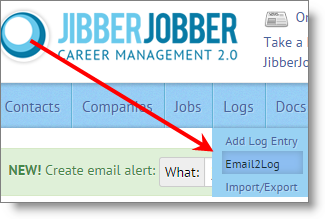
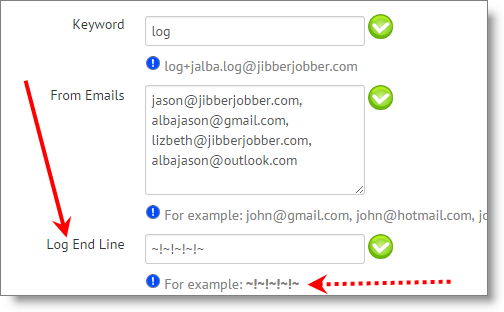

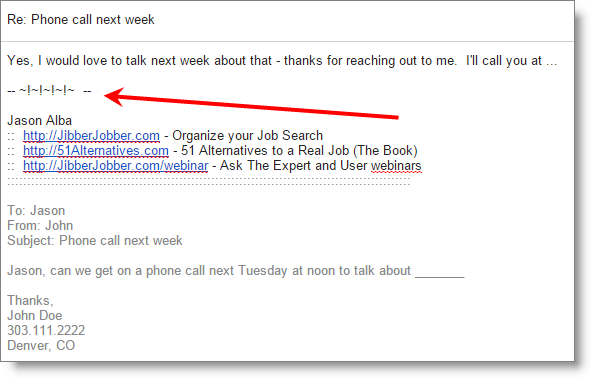
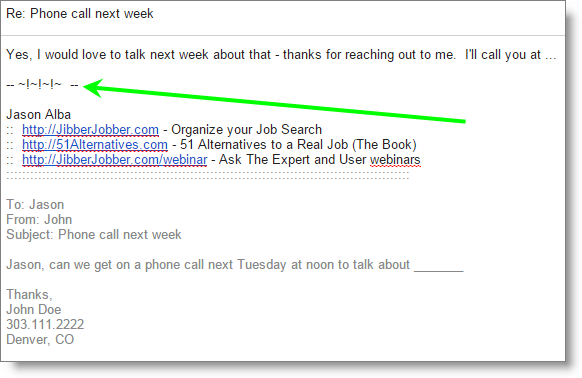

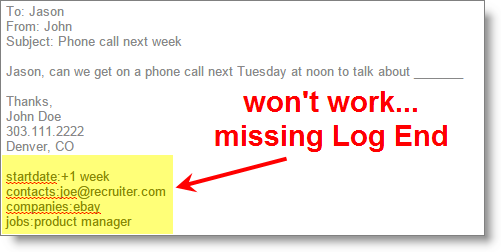
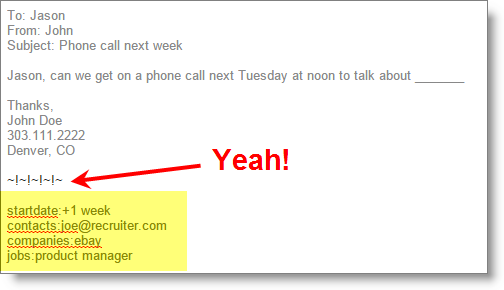
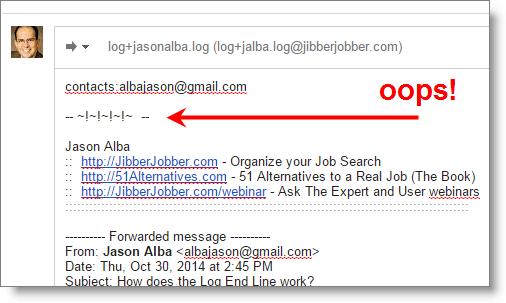
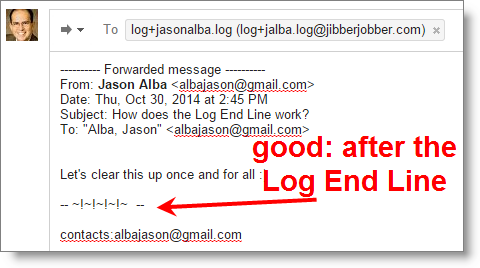
Hey Joe,
I put the startdate and actions in white – they are still there but no one can see them and low and behold it turns up in my action log! So no one can ask questions about what this startdate thing is etc…
Invisible magic…
best
Andrew
And I meant Jason in my note -! duh. Sorry about that – feel free to change it.
No problem Andrew… been called worse 🙂
Great idea… I like your approach… some people have told me that they like the idea, but if you print out the email then it still prints out, even though you changed the font to white… I am not too worried about that, so my preference is to do what you recommend 🙂